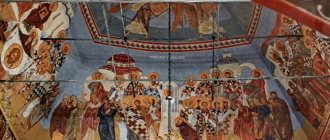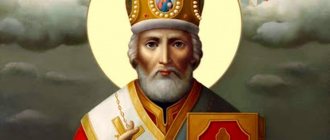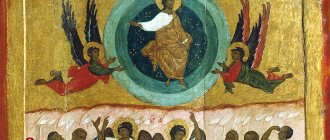Hieromartyr Lawrence of Rome, Archdeacon
Lives of the Hieromartyrs Lawrence, Archdeacon, Sixtus II, Pope of Rome, Felixsimus and Agapitus, Deacons, and the Martyr Romanus
The martyrs Archdeacon Lawrence, Pope Sixtus, deacons Felikissimus and Agapitus, and the warrior Romanus of Rome suffered in 258 under the emperor Valerian (253–259).
Saint Pope Sixtus, a native of Athens, received a good education, preached in Spain and was installed as a bishop in Rome after the martyrdom of Saint Pope Stephen (253-257, Comm. August 2). This was the time when the pope who occupied the Roman throne was elected to certain death. Soon Saint Sixtus was also captured and thrown into prison along with his two deacons Felicissimus and Agapitus. When the holy Archdeacon Lawrence met Pope Sixtus, who was being led to prison, he exclaimed with tears: “Where are you going, father? Why do you leave your archdeacon, with whom you always made the Bloodless Sacrifice? Take your son with you, so that I too may be your partner in shedding blood for Christ!” Saint Sixtus answered him: “I will not leave you, my son. I am an old man and am going to an easy death, but you face more severe suffering. Know that three days after our death you will follow me. Now go, sell the church treasures and distribute them to persecuted and needy Christians.” Saint Lawrence fulfilled the saint's behest with zeal. Hearing that Saint Pope Sixtus had been taken with the deacons to trial, Saint Lawrence went there to see their feat and said to the saint: “Father, I have already fulfilled your order, I have distributed the treasure you have given me, do not leave me!” Hearing about some treasure, the soldiers took it into custody, and beheaded the martyrs with a sword († August 6, 258). The emperor imprisoned Saint Lawrence and assigned the prison governor, Hippolytus, to oversee him. In prison, Saint Lawrence healed the sick who gathered to him with prayer and baptized many. Amazed by this, Hippolytus himself believed and received Baptism from Saint Lawrence with his entire household. Soon Archdeacon Lawrence was again brought to the emperor with orders to show the hidden treasures. Saint Lawrence replied: “Give me three days, and I will show you these treasures.” During this time, the saint gathered many poor and sick people who fed only on the alms of the Church, and, bringing them, announced: “These are the vessels in which the treasures are placed. And everyone who puts their treasures into these vessels will receive them in abundance in the Kingdom of Heaven.”
After this, Saint Lawrence was given over to the most severe tortures, forcing him to worship idols. The martyr was beaten with scorpions (a thin iron chain with sharp needles), his wounds were seared with fire, and he was beaten with tin rods. During the suffering of the martyr, the warrior Roman suddenly exclaimed: “Saint Lawrence, I see a bright young man standing next to you and wiping your wounds! I conjure you by the Lord Christ, do not leave me!” After this, Saint Lawrence was taken off the rack and sent to prison to Hippolytus. Roman brought a pot of water there and begged the martyr to baptize him. Immediately after the Baptism, the soldiers cut off his head († August 9). When the martyr Lawrence was taken to his final trial, Saint Hippolytus wanted to declare himself a Christian and die with him, but the confessor said: “Hide your confession in your heart now. After a little time I will call you, and you will hear and come to me. But don’t cry for me, rather rejoice, I’m going to receive the glorious crown of martyrdom.” They laid him on an iron grate, under which they placed hot coals, and the servants pressed the body of the martyr to it with spears. Saint Lawrence, looking at the rulers, said: “Behold, you have baked one side of my body, turn it to the other and eat my body!” Dying, he said: “I thank You, Lord Jesus Christ, that You have made me worthy to enter Your gates,” and with these words he gave up the ghost.
Saint Hippolytus took the body of the martyr at night, wrapped it in swaddling clothes with aromas and let the presbyter Justin know. An all-night vigil and Divine Liturgy were celebrated over the relics of the martyr in the house of the widow Kyriacia. All Christians present received Holy Communion and honorably buried the body of the holy martyr Archdeacon Lawrence in the cave on August 10, 258. Saint Hippolytus and other Christians suffered three days after the death of Saint Lawrence (August 13), as he predicted to them about it.
See also: “ The suffering of the holy martyrs Lawrence the Archdeacon, Sixtus the Pope and others with them” as presented by St. Demetrius of Rostov.
LAVRENTY
In the IV-V centuries. a legend arose about L., later. forming the basis of hagiographical tales, which in the Middle Ages and Modern times remained the most important sources of information about the martyr. The earliest version of this legend was given by St. Ambrose of Milan in his treatise “On the Duties of the Clergy” (c. 388). Discussing the behavior of the ministers of the Church and the proper use of church property, Ambrose pointed to the feat of L., who gave Christians an example of courage and fortitude (fortitudo) in the face of torture and death. The guards grabbed Sixtus II and took him to execution. Seeing L. crying, the bishop predicted that he was destined to suffer a painful death in 3 days (about this dialogue, see: Lanéry. 2006). At the request of the persecutors, L. agreed to give them the treasures of the Roman Church, but instead distributed the valuables to the poor. The next day, when he was demanded to fulfill his promise, the deacon pointed to the poor and declared that they were the treasure of the Church. According to Ambrose, for his exceptional wit (pro singulari suae interpretationis vivacitate), L. was subjected to a cruel execution: the “deceived tyrant” ordered him to be roasted alive on an iron grate (craticula). Overcoming the pain, the deacon exclaimed: “Ready, turn over and taste” (Assum est, inquit, uersa et manduca) (Ambros. Mediol. De offic. I 41; II 28 // PL. 16. Col. 84-86, 141- 142). Ambrose cited these words of L. addressed to the executioner as an example of fortitude and contempt for death in a letter to the Venerable. Simplician (Bishop Mediolanus in 397-400/1) (Idem. Ep. 37 (54). 36-37 // PL. 16. Col. 1093).
Archdeacon. sschmch. Lawrence accepts the treasures of the Church from Pope Sixtus II and distributes alms. Painting of the chapel of Pope Nicholas V in the Papal Palace in the Vatican. Artist Fra Angelico. OK. 1447–1450 Archdeacon. sschmch. Lawrence accepts the treasures of the Church from Pope Sixtus II and distributes alms. Painting of the chapel of Pope Nicholas V in the Papal Palace in the Vatican. Artist Fra Angelico. OK. 1447–1450
Archdeacon. sschmch. Lawrence accepts the treasures of the Church from Pope Sixtus II and distributes alms. Painting of the chapel of Pope Nicholas V in the Papal Palace in the Vatican. Artist Fra Angelico. OK. 1447–1450
Archdeacon. sschmch. Lawrence accepts the treasures of the Church from Pope Sixtus II and distributes alms. Painting of the chapel of Pope Nicholas V in the Papal Palace in the Vatican. Artist Fra Angelico. OK. 1447–1450
In the hymn "Apostolorum supparem", composed either by St. Ambrose, or someone from his entourage, also reported on the prediction of Sixtus II and that the persecutors ordered L. to hand over the church treasury. Pretending that he agreed to carry out the order, the deacon brought poor Christians, whom he called “the property of the Church.” The greedy official flew into a rage and ordered L. to be put to slow death by fire. During the execution, the flame burned the executioner, and the dying martyr said: “Turn me over and devour me if I am fried” (Versate me, martyr uocat, / uorate, si coctum est, iubet - PL. 17. Col. 1216-1217; Early Latin Hymns / Ed. AS Walpole. Camb., 1922. P. 97-104; see: Jullien. 1989; Nauroy. 1989; Benvenuti, Giannarelli. 1998. P. 27-35).
The legend of L.'s martyrdom is set out in the poem by Prudentius from the cycle “The Crowns of the Martyrs” (Prudent. Perist. 2). The poet gives details that are absent from St. Ambrose. The persecutors crucified Sixtus II, and L. wept at the foot of the cross. The bloodthirsty prefect of Rome demanded that the deacon hand over valuables allegedly needed by the treasury. Recognizing that the Church had enormous wealth at its disposal, L. promised to give “that dear thing that Christ has” and received a 3-day reprieve. Gathering all the needy, sick and crippled Christians, he showed the prefect the square filled with people. The poet put into L.’s mouth a speech that the true treasure of Christ is people with a pure soul; Unlike healthy and rich pagans, these people are poor and ugly, but spiritual beauty is hidden behind their physical ugliness, therefore they are a true adornment of the Church. Before his death, L. prayed that the Romans would believe in Christ and free themselves from slavish service to idols. Prudentius attributes to the martyr a prophecy about the triumph of Christ. faith in the Roman Empire.
In the epic poem Prudentius L. is presented as a Christ. a hero who “destroyed death by death.” The death of the martyr marked the collapse of paganism: thanks to his feat, Rome, enslaved by superstition, regained its freedom (Laurentio uictrix duce / ritum triumfas barbarum) (according to Ambrose, the martyr led the Romans in their triumph over pagan errors). L.'s feat was not only a symbol of the victory of Christianity over paganism, but also an example of heroic virtue. If St. Ambrose argued that the martyr's devotion to Christ was stronger than the friendship of Orestes and Pylades, the ancient Greek heroes. tragedies, then Prudentius described L. as a “new Aeneas” who surpassed ancient Rome. heroes (Buchheit. 1971). The suffering of the martyr in the poem is given less attention than the moralizing opposition of Christ. virtues to pagan vices. At the same time, Prudentius endowed the image of L., created by him, with the features of a trickster: having played a joke on the greedy prefect, the martyr provoked him to cruelty and, having accepted death, won a victory over paganism. If the ancient heroes were portrayed as stern, courageous people, then Prudentius used playful erotic allusions (in the description of the execution of L.) and ambiguous allegories, speaking of the “fatherly love” of the martyr for the Romans, contained in his “mammalian breast” (...tuosque alumnos urbicos / lactante complexus sinu / paterno amore nutrias) (see: Conybeare. 2002). However, the teaching about vices and virtues, put by the poet into L.’s mouth, corresponded to ideas about traditions. Rome. values, and the heroic death of the martyr was a feat that overshadowed the deeds of the heroes of Dr. Rome. Thus, Prudentius sought to demonstrate that Christ. the morality and exploits of the martyrs surpassed Roman ideas about virtue, although they did not contradict them (see: Benvenuti, Giannarelli. 1998. P. 35-44; Fux. 2003).
Archdeacon. sschmch. Lawrence with Christians before the Prefect of Rome. Painting of the Cathedral of Genoa. Artist L. Tavarone. 1622
Archdeacon. sschmch. Lawrence with Christians before the Prefect of Rome. Painting of the Cathedral of Genoa. Artist L. Tavarone. 1622
Preachers also turned to L.’s feat, including Blessed. Augustine. In Carthage and Hippo (now Annaba, Algeria), Augustine preached at least 7 sermons on the day of memory of L. Most often, the preacher pointed to the feat of the martyr as an example for all Christians, spoke about the need to honor the saints and imitate their virtues (Aug. Serm. 302 -305A; Idem. In Ioan. XXVII 12; see: Benvenuti, Giannarelli. 1998. P. 46-54). In Italy St. Maxim Taurinsky dedicated 2 sermons to L.’s fiery faith and his ardent love for Christ, likening the martyr to a mustard seed from the Gospel parable (Matthew 13.31-32; Mark 4.30-32; Luke 13.18-19) (Maxim. Taurin. Serm. 4, 24). In the sermon of St. Leo I the Great, Pope of Rome, also speaks of the martyr’s firmness and his love for Christ; like Prudentius, the pontiff compared L. with the First Man. Stefan (Leo Magn. Serm. 72 (85)). Among the works of Maxim Tavrinsky, 5 sermons have been preserved on the day of memory of L., which in the present day. time are considered inauthentic (PL. 57. Col. 407-414, 677-679, 681-682). St. Peter Chrysologus was previously credited with preaching a brief retelling of the legend of the martyrdom of L. (PL. 52. Col. 565-567). Apparently, these homilies were compiled in the 5th-6th centuries, most likely in Italy. Blzh. Augustine, St. Maxim, St. Leo the Great and other preachers relied mainly on the treatise of St. Ambrose “On the duties of the clergy” and the hymn “Apostolorum supparem” (see: Nauroy. 1989. P. 60-78; Benvenuti, Giannarelli. 1998. P. 54-64).
The earliest hagiographic work that describes the feat of L. is the Martyrdom of Sixtus, L. and Hippolytus, or “Passio vetus”, compiled no earlier than the middle. V century The author of the text was most likely a cleric who served in Rome. Basilica of San Lorenzo Fuori le Mura (Verrando. 1990. P. 178-179; ed.: Idem. 1991). Apparently, before the creation of “Passio vetus”, oral stories about the martyr were widespread, which were used by Ambrose, Prudentius and other early authors, supplementing them with fictitious details (Lanéry. 2006. P. 60; cp.: Nauroy. 1989. P. 45). The text of “Passio vetus” has a complex history: numerous manuscripts (J. N. Verrando’s edition includes 36 manuscripts created no later than the 13th century) contain both individual parts and contaminated versions of the legend. According to Verrando, the original edition of the Passio vetus has not survived; closest to it is the version presented in one of the early Carolingian legendaries (Monac. Clm. 4554. Fol. 86r - 88r; turn of the 8th and 9th centuries, Benediktbeuern Abbey).
Martyrdom of the Archdeacon. Lawrence. Painting of the crypt of Sant'Epifanio in the monastery of San Vincenzo al Volturno. 824–842
Martyrdom of the Archdeacon. Lawrence. Painting of the crypt of Sant'Epifanio in the monastery of San Vincenzo al Volturno. 824–842
In "Passio vetus" the death of Sixtus II and L. is mistakenly associated with the rise to power of the emperor. Decius (249-251), presented as a cruel persecutor of Christians. Upon learning of Decius's imminent arrival in Rome, the bishop called on all Christians to prepare for martyrdom. To prevent church property from falling into the hands of the authorities, Sixtus II handed it over to the archdeacon. L., who sold valuables to Christians and distributed the money to the poor. Decius brought the Persians to Rome. Christians Abdon and Sennen, whom he tortured for refusing to renounce Christ and eventually killed. After Sixtus II, who refused to bow to the pagan gods, was beheaded, the emperor ordered L. to hand over the church treasures and gave him a 2-day reprieve. The military commander Hippolytus was assigned to monitor the archdeacon. Seeing that L. was collecting poor Christians, Ippolit suspected deception and ordered to show where the valuables were hidden. The archdeacon promised to give him countless treasures if he believed in Christ. Having witnessed how L. healed the blind, Hippolytus converted to Christianity. At the appointed time, the archdeacon came to the emperor along with many beggars, whom he called “the imperishable treasure of the Church.” By order of the angry Decius, the prefect of the city, Valerian, tortured the martyr in the palace of Tiberius. When they began to fry him on the grill, L. courageously endured suffering and gave up the ghost. Hippolytus secretly took his body and buried him in an underground crypt; Having learned about this, the emperor executed the military leader. On the 7th day after his death, during the ceremonial entry into the amphitheater, Decius and Valerian were punished for cruelty with sudden death.
An expanded version of the legend about L. is presented in the hagiographic novel known as the Martyrdom of Polychronia (BHL, N 4753; ed.: Delehaye. 1933). According to I. Delee, Martyrdom was created in Rome at the turn of the 5th and 6th centuries. (approx. 500 - Dufourcq. 1900. P. 309). It included tales about several. Rome. martyrs, including Sixtus II, L. and Hippolytus. The story of L. begins with the return to Rome of Decius, who allegedly seized power after the death of the emperor. Galba (68-69). With the help of Prefect Valerian, the new emperor began to brutally persecute Christians. Pope Sixtus II, captured by persecutors, predicted that L. would die in 3 days, and instructed him to take care of the treasures of the Church. Fulfilling the last will of the bishop, L. looked for poor Christians, distributed money to them and looked after them; He also healed the widow Kyriakou, who was sheltered by Christ. clerics from the persecutors, and the blind Crescention. In the meantime, Bishop Sixtus II and the deacons Felicissimus and Agapitus were condemned to death. When L. learned of the verdict, he exclaimed: “Do not leave me, holy father, because I have already disposed of the treasures that you gave me.” Hearing these words, the guards grabbed him and brought him to the tribune Parthenius, who reported to the emperor that L. had hidden church valuables. Wanting to take possession of the treasures, Decius ordered the prefect Valerian to find them, and he instructed the vicar Hippolytus to guard the archdeacon. In prison, L. healed the blind Lucillus and converted Hippolytus and his household to Christ. The prefect ordered the archdeacon to hand over the valuables in 3 days, and he took advantage of the delay to collect the poor and crippled. With the help of Hippolytus, the archdeacon brought them to the palace of Sallust, where the emperor was, and presented them as “the imperishable treasure of the Church.” They demanded that he renounce Christ, and after his refusal he was beaten and scourged. By order of Decius, the archdeacon was taken to the palace of Tiberius and his trial was held in the Basilica of Jupiter. There L. again refused to bow to idols and was again severely beaten (the text emphasizes that the persecutors first of all demanded that he renounce his faith; less attention is paid to the issue of treasures). Seeing the martyr’s fortitude, the guard Roman believed in Christ and was baptized, but was soon captured and executed. At night, the emperor and prefect held a trial in the Baths of Olympias near the Palace of Sallust, preparing many torture instruments. At the last interrogation, L. stated that he was a native of Spain, but grew up in Rome. By order of Decius, he was laid on an iron bed “like a lattice” and roasted over low heat. Despite the pain, the martyr continued to argue with the emperor, and he ordered him to be fried alive. Before his death, looking into Decius’s face, L. offered to turn him over and try the “roast.” At dawn, Hippolytus stole L.'s body and, together with the Rev. Justin, to whom he told about the sufferings of the martyr, buried him on the land of the widow of Kyriaki on the Tiburtine road. The following tells about the death of Hippolytus and other martyrs and about the punishment that befell Decius and Valerian.
Pope Sixtus II and Archdeacon. Lavrenty. Mosaic “Procession of Martyrs” in the c. Sant'Apollinare Nuovo in Ravenna. 1st half VI century
Pope Sixtus II and Archdeacon. Lavrenty. Mosaic “Procession of Martyrs” in the c. Sant'Apollinare Nuovo in Ravenna. 1st half VI century
In the Liber Pontificalis, in a brief biography of Pope Sixtus II, information about L. is given, which resembles the Martyrdom of Polychronius, but diverges from it in detail. It is stated here that L. suffered 3 days after the death of Sixtus II; the subdiacs were executed along with him. Claudius, Rev. Severus, reader Crescentius and ostiary Romanus. As in the hagiographical tales, the pontificate of Sixtus II is erroneously dated to the reign of the emperors Valerian and Decius (LP. T. 1. P. 155; see: Benvenuti, Giannarelli. 1998. P. 73-74).
The tales of L.'s martyrdom are largely legendary. The researchers pointed out “the complete lack of credibility in this whole story” (Serra. 2015. P. 37). According to Delehaye, L. most likely was a historical person, but reliable information about him cannot be distinguished from fictional ones (Delehaye. Légendes. P. 104). Anachronisms and factual errors contained in hagiographical tales show that Rome. hagiographers had little idea about the events of the Ser. III century The method of execution to which L. was subjected does not agree with reliable data about the persecution of Valerian (as a rule, martyrs’ heads were cut off; the only example of public execution by burning was the death of Bishop Fructuosus and 2 of his deacons in January 259 in Tarracona (now Tarragona, Spain)). Cruel torture and painful methods of execution began to be used against Christians only in the era of the tetrarchy (286-324) (Franchi de' Cavalieri. 1900; Delehaye. 1933. P. 49-50). P. Franchi de Cavalieri pointed out the similarities between the legend about the execution of L. and the legend about the Phrygian martyrs who died under the emperor. Julian the Apostate (361-363), which is cited by church historians Socrates Scholastic (Socr. Schol. Hist. eccl. III 15) and Sozomen (Sozom. Hist. eccl. V 11) (Franchi de' Cavalieri. 1915). Like L., these martyrs were roasted alive on an iron grate; During the execution, they courageously demanded that the executioners turn them over on the other side (Delee considered the analogy indicated by Franchi de Cavalieri with a replica of the Gallic martyr Attalus (Euseb. Hist. eccl. V 1. 52) to be insignificant). According to Delee, we are talking about lit. a motif that originated in the East and was borrowed from Western countries. by the authors who included it in the legend of L. (AnBoll. 1900. T. 19. P. 452-453; see also: Delehaye. Légendes. P. 97-98; Idem. 1933. P. 55-58). This assumption is not entirely convincing, because in the 80s. IV century the legend about the execution of L. was already known to Ambrose of Milan, and the testimonies of Socrates and Sozomen date back to a later time.
Based on early evidence, it is difficult to judge where and under what circumstances the legend about L. The statement of St. Ambrose that L. died 3 days after the execution of his bishop is consistent with Rome. liturgical tradition, in which the commemoration of Sixtus II took place on August 6, and L. - on August 10. Information about the method of execution of the martyr and about the demand of the persecutors to hand over treasures may be related to the so-called. the great persecution of Christians in the beginning. IV century, when the authorities confiscated church property. Dr. details could go back to secular literature. stories. Thus, the scene in which L. showed the persecutors of the poor, “the treasure of the Church,” was most likely inspired by the legend about the mother of the Gracchi, who, in response to a request to show the jewelry, brought her sons (Val. Max. Mem. IV 4; see .: Delehaye. 1933. P. 58). St. Ambrose, blessed Augustine and the authors of sermons called L. both deacon and archdeacon; according to Prudentius, the martyr was the eldest among the 7th Romans. regional deacons (hic primus a septem viris). The custom of calling the senior deacon of the Roman Church archdeacon is attested in the 2nd half. IV century (Gesta inter Liberium et Felicem // Coll. Avel. Pars 1. P. 1-2; see: Di Berardino A. Archdeacon // Encyclopedia of Ancient Christianity. Downers Grove (Ill.), 2014. Vol. 1. P 219).
Archdeacon. sschmch. Lavrenty. Fragment of the painting of Chapel No. 9 of San Lorenzo Fuori le Mura in Rome. Ser. XI century
Archdeacon. sschmch. Lavrenty. Fragment of the painting of Chapel No. 9 of San Lorenzo Fuori le Mura in Rome. Ser. XI century
Iconographic monuments do not allow us to trace the formation of the legend about the death of L. The earliest images of the martyr were preserved on medallions made by Rome. masters of the IV-V centuries. using the “gold glass” technique (a thin gold sheet with a cut-out image was placed between 2 layers of glass). On them, L. is presented without the attributes of martyrdom, usually together with the apostles Peter and Paul, Cyprian of Carthage, Sixtus II or Hippolytus (see: Morey Ch. R. The Gold-glass Collection of the Vatican Library / Ed. G. Ferrari. Vat., 1959. P. 10-11, 43, 49, 75). On the mosaics of the oratory at the c. The Holy Cross in Ravenna, known as the mausoleum of Galla Placidia (1st half of the 5th century), depicts a martyr with a processional cross and an open book, walking against the background of a lattice bed, under which a fire is blazing. It is generally accepted that this martyr is L., but other opinions have been expressed (see: Mauskopf Deliyannis. 2010. P. 78-79). On the fresco in the catacombs of San Senatore in Albano Laziale (late 5th century) L. is presented together with the apostles Peter and Paul standing before Christ and the martyr. Smaragd; in his hand he has a cross and a book. Thus, the earliest images of L. with attributes of martyrdom date back to the 5th century. (the scene of L.’s execution in the presence of the emperor was presented on the now lost bronze medallion of Sucess (IV century?), but the authenticity of the medallion remains in question; see: Leclercq. 1929. Col. 1926-1927; Serra. 2015. P. 50 -51). On the mosaic of the 6th century. in the Basilica of San Lorenzo Fuori le Mura, in the open book held by L., the text of Ps 111. 9 (Dispersit dedit pauperibus) is placed. This verse, indicating the duties of a deacon and the circumstances of L.’s death, was used in liturgical chants in honor of the martyr. The earliest depictions of L.'s execution date back to the Carolingian era, for example. fresco in the crypt of Abbot Epiphanius in the monastery of San Vincenzo al Volturno (2nd quarter of the 9th century) and a miniature in the Sacramentary of Drogon of Metz (mid 9th century) (Paris. lat. 9428. Fol. 89r) .
In the Middle Ages, various versions of the legend about L. became widespread in the West. The Martyr was often presented as an exemplary servant of the Church and its defender from the encroachments of greedy rulers. The relevance of this interpretation of the image of L. was associated with conflicts between Catholics. Church and secular monarchs. Numerous editions of the Martyrdom of L. are known (BHL, N 4753-4772), on which the legends about the martyr in the “historical” martyrologies of the Carolingian era are based. Thus, the most detailed legend in the martyrology of Adon of Vienne is an epitome of the corresponding chapters of the Martyrdom of Polychronius. Old English is also based on this source. version of the Martyrdom of L. as part of the 1st series of “Catholic Sermons” by Abbot Elfric (late 10th century; ed.: The Homilies of the Anglo-Saxon Church / Ed. B. Thorpe. L., 1844. Vol. 1. P. 416-437). A poetic adaptation of the legend about L. and other martyrs who suffered with him was included by Flodoard of Reims in the poem “The Victories of Christ in Italy” (PL. 135. Col. 685-688; see: Jacobsen P. Ch. Flodoard von Reims: Sein Leben und seine Dichtung "De triumphis Christi". Leiden, 1978. S. 252-253). Among Lat. metrical versions of the legend about L. - “Poems about St. Lawrence" Marboda, bishop. Rennes (PL. 171. Col. 1607-1614), “Martyrdom of St. Lawrence" by the Benedictine Nigel of Canterbury (Nigel of Canterbury. 1994) and the poem of William of Massenago (AnBoll. 1892. T. 11. P. 313, 318-320). Sermons, hymns and other writings about L. belong to the theologian, historian and hagiographer Regnier († 1188), who lived in the Abbey of St. L. in Liege. There are known tales about the martyr in national languages, for example, the Anglo-Norman poetic Life of L. (between 1140 and 1170 - La Vie de Saint Laurent. 1976), the Castilian poem by Gonzalo de Berceo “The Passion, or the Martyrdom of St. Lawrence" (mid-13th century - Gonzalo de Berceo. 1971), prose studies. version of the Martyrdom of L. (see: Wolf. 2013).
In the Middle Ages. In hagiographic works, the narrative of L.'s martyrdom was often supplemented by tales of the martyr's miracles, borrowed from various sources. Such legends were included by Gregory of Tours in the collection. “On the Glory of the Martyrs”: they tell about the lengthening of a beam that was too short during the construction of a church in honor of L. and about the broken liturgical chalice, which was soon found unharmed (Greg. Turon. Glor. martyr. 41, 45). A poem by Venantius Fortunatus (Venant. Fort. Carm. IX 14) is also dedicated to the miracle of the beam (cf. later tales of miracles in L. - BHL, N 4784-4787).
In the XIII-XV centuries. information about L. was included in legendaries and historical works. Thus, brief tales based on the texts of the Martyrdom are contained in the legendarium of Jean de Mailly (Jean de Mailly. 2013) and in the encyclopedia of Vincent of Beauvais (Vincentii Burgundi Bibliotheca mundi, seu Speculum maius. Duaci, 1624. T. 4. P. 442 -443). Blzh. Jacob of Varazze included in the “Golden Legend” a lengthy tale about the martyr, in which he used numerous sources, including the works of St. Ambrose, blessed Augustine, St. Leo the Great. The hagiographer disputed the authenticity of the legend about Spain. the origin of L., given by the French. liturgist John Belet († c. 1182), and pointed out the erroneous dating of the death of the martyr during the reign of the emperor. Decius. The narrative about L. is accompanied by descriptions of miracles and teachings based on the sermons of Augustine and other authors (Iacopo da Varazze. 1998). The narrative from the “Golden Legend,” along with the Martyrdom of Polychronius and the legend from the martyrology of Adon, became the most important source of information about L.; hagiographers of the late Middle Ages and Modern times relied on it. The tale of Jacob of Varazze was used in French. drama "Miracle of St. Lawrence" (c. 1380), included in the collection. “Miracles of Our Lady” (Miracles de Nostre Dame. 1883), and in the mystery of L. (late 15th century - Le Mystère. 1890). Their compilers freely interpreted the legend of the martyr; Fantastic details, fictional scenes and characters are introduced into the plot of the mysteries.
Patronage
- Against fire
- Against lumbago
- Archives and Archivists
- Armory and Gunsmiths
- B-B-Q
- Brewers
- Butchers
- Comedians
- Chefs, cooks and restaurant owners
- Cutlers
- Deacons
- Glaziers and stained glass workers
- Laundry workers
- Libraries and librarians
- Miners
- Beggars and poor people
- Seminarists
- Students
- Tanners
- Vineyards, winemakers and wine sellers
- Abano Terme, Italy
- Alba, Italy
- Angrogna, Italy
- Berzo Demo, Italy
- Berzo Inferiore, Italy
- Brissogne, Italy
- Cabella Ligure, Italy
- Camino, Italy
- Canada
- Cavatore, Italy
- Chambavey, Italy
- Denis, Italy
- Esbonderup, Denmark
- Folgaria, Italy
- Gamalero, Italy
- Gross Hartach, Germany
- Gyorschemer, Hungary
- Huesca, Spain
- Il Birgu, Malta
- Limbazi, Latvia
- Lund, Sweden
- Montevarchi, Italy
- Mortara, Italy
- Naurod, Germany
- Oldenburg, Lower Saxony, Germany
- Pontinvrea, Italy
- Rome
- Rotterdam
- San Lawrenz, Malta
- Santena, Italy
- Scala, Italy
- Seravezza, Italy
- Sri Lanka
- Tivoli, Italy
- Zagarolo, Italy
Source[23][24]
Heritage
According to Francesco Moraglia, the role of the deacon is distinguished by its service to the poor. He is destined both to serve at the table (corporal works of mercy) and to serve the word (spiritual works of mercy). “The beauty, strength and heroism of people like Lawrence help to reveal and come to a deeper meaning of the special nature of the diaconal ministry.”[6]
El Escorial, near Madrid, laid out in a grid-like pattern.
Many churches, schools, parishes, cities and geographical features around the world are named after Lawrence of Rome. Depending on the area they are called St. Lawrence
,
St. Lawrence
,
San Lorenzo
,
St. Laurent
,
St. Lawrence
or similar in other languages. San Lorenzo del Escorial, a monastery built by King Philip II of Spain, celebrates his victory at the Battle of Saint Quentin (1557) on the Feast of Saint Lawrence.[20] The monastery and the adjacent palace, college and library are arranged in a grid pattern that resembles the grid of Laurentian martyrdom. The Laurentian grille is also considered to be the basis of the structure of the Certosa di San Lorenzo di Padula, which is a monastery in Padula, Salerno, Italy. Two universities bear his name: St. Lawrence University (non-Catholic) in Canton, St. Lawrence County, New York, United States, and St. Lawrence University in Kampala, Uganda.
On his second voyage, French explorer Jacques Cartier, having arrived at the river estuary from the Great Lakes of North America on the Feast of St. Lawrence in 1535, named it the Gulf of St. Lawrence
.[21]The river flowing into the bay was named
the St. Lawrence River
.
Many names in what are now Quebec and the Maritime Provinces of Canada link to this important sea route, e. g., Laurentian Mountains
north of the city of Montreal, Saint-Laurent (urban district), St. Lawrence Boulevard which spans the width of the Island of Montreal, and St. Lawrence Parish, New York, United States near Lake Ontario.
The rescue operation for miners trapped in the 2010 Copiapo mine accident in Chile was named Opera San Lorenzo
in honor of Lawrence, the patron saint of miners.[22]
In Freemasonry the Order of St. Lawrence Martyr
A Masonic degree whose ritual is based on the story of Lawrence. It is one of the constituent degrees of the Union Masonic Degrees.
In popular culture
| This section provides self-contained examples of popular culture without describing their meaning in the context of the article. Please help improve this section by adding citations to reliable sources that describe the meaning of the examples, and removing less relevant examples. |
In Fargo
, Season 1, Episode 3, Lorne Malvo notices the St. Lawrence stained glass window in Stavros' office, in response to which Stavros talks about his martyrdom, in "Dirty Road".
In the video game Dota 2
done by Valve, Lina the Slayer's dying voice line "Turn me over... I'm done" is a reference to Lawrence of Rome.[25]
In a scene from the 1992 film Lorenzo's Oil
, Augusto, Micaela and Lorenzo tell the story of St. Lawrence and call his holiday "Night of the Falling Stars".[26]
Recommendations
- ^ a b c
Citing St. Donato as a primary source.
Janice Bennett. Saint Lawrence and the Holy Grail: The Story of the Holy Chalice of Valencia
. Littleton, CO: Libri de Hispania, 2002. p. 61. - ^ a b
Citing Francisco Diago and Saint Donato as sources.
Janice Bennett. Saint Lawrence and the Holy Grail: The Story of the Holy Chalice of Valencia
. Littleton, CO: Libri de Hispania, 2002. Pages 15 and 62. - Janice Bennett. Saint Lawrence and the Holy Grail: The Story of the Holy Chalice of Valencia
. Littleton, CO: Libri de Hispania, 2002. p. 61. - St. Orentius and Patentia Catholic Internet
- ^ a b c d
""Saint Lawrence, the martyr deacon, "is rumored to have been martyred by being put on the bars. Orthodox Christian Church of St. Lawrence" (PDF). Archived from the original (PDF) on October 19, 2013. - ^ a b
"Moraglia, Father Francesco", St. Lawrence, Protodeacon of the Vatican Church of Rome. - Saint Ambrose, De officiis ministrorum,
2.28 - ^ a b c
Fri.
Paolo O. Pirlo, SHMI (1997). "Saint Lawrence". My First Book of Saints
. Sons of St. Mary Immaculate - Quality Catholic Publications. pp. 176–178. ISBN 971-91595-4-5. - ^ a b c
"Kirsch, Johann Peter". Lawrence. "Catholic Encyclopedia. Volume 9. New York: Robert Appleton Company, 1910. February 9, 2013.” - ^ a b
Foley, OFM, Leonard, "Saint Lawrence",
Saint of the Day, Lives, Lessons and Feast
(Edited by Pat McCloskey, OFM), Franciscan Media ISBN 978-0-86716-887-7 - ^ a b c d
Rev. Patrick Joseph Healy (1905).
The Persecution of Valerian: A Study of the Relationship between Church and State in the Third Century AD.
. Boston, Massachusetts: Houghton, Mifflin, & Co. - Parrocchia Santa Maria Assunta in Amaseno, Lazio, Italy; "I Luogi di San Lorenzo a Roma"; [2]; accessed March 13, 2017
- Parrocchia Santa Maria Assunta in Amaseno, Lazio, Italy;
- Owens, B. (2003). "Preservation of Memory: The Divine Function of the Librarian and Archivist." Library and Archival Security
, 18(1), 9–41 - Parrocchia Santa Maria Assunta, Amaseno, “I Luoghi di San Lorenzo a Roma”, [3], accessed 13 March 2022.
- See, for example, The Anglican Prayer Book (1989), Province of South Africa, published by Collins Liturgical, ISBN 0 00 599180 3, Calendar, p. 24.
- See the main edition of Common Worship (2000), published by Church House Publishing, ISBN 0 7151 2000 X, Calendar, page 12.
- Oxford Dictionary of Saints
, published by Oxford University Press, ISBN 0 19 283069 4 (paperback), 228 churches mentioned. - The Official Index of the Church of England (ACNY) cites 224 words "Lawrence" and "Lawrence".
- Review by Fodor (2008). "The real monastery of San Lorenzo de El Escorial."
- Johnson, William Henry (20 May 2007). French Pathfinders in North America
. Gutenberg.org. Retrieved February 27, 2011. - Oppman, Patrick. “Faith Key for Chilean Miners and Their Families,” CNN, September 9, 2010.
- "Saint Lawrence of Rome." CatholicSaints.Info
. October 26, 2008. Retrieved March 29, 2022. - https://lundsdomkyrka.se/fordjupning/st-laurentius/
- dota2.gamepedia.com/Lina#Trivia
- https://www.quodb.com/search/la%20notte%20de%20san%20lorenzo?title_keys=M1169778c4










